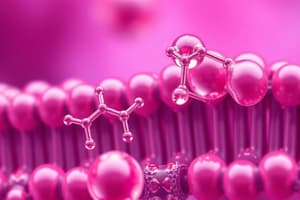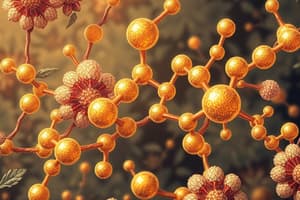Podcast
Questions and Answers
What property primarily contributes to lipids being insoluble in water?
What property primarily contributes to lipids being insoluble in water?
- Presence of nitrogen bonds
- High molecular weight
- Long chains of hydrocarbon (C-H) bonds (correct)
- Presence of polar groups
Which of the following is a characteristic of saturated fatty acids?
Which of the following is a characteristic of saturated fatty acids?
- All C-C bonds are single bonds (correct)
- Have a branched structure
- Are always found in liquid state
- Contain one or more double bonds
Which lipid type is classified as a glyceride?
Which lipid type is classified as a glyceride?
- Steroids
- Waxes
- Triglycerides (correct)
- Phospholipids
What defines unsaturated fatty acids?
What defines unsaturated fatty acids?
Lipids serve multiple functions in biological systems, but which of the following is NOT a function of lipids?
Lipids serve multiple functions in biological systems, but which of the following is NOT a function of lipids?
Which type of lipids is characterized by having structures like micelles when mixed with water?
Which type of lipids is characterized by having structures like micelles when mixed with water?
Which statement accurately describes complex lipids?
Which statement accurately describes complex lipids?
Which of the following descriptions of fatty acids is true?
Which of the following descriptions of fatty acids is true?
Which fatty acid is classified as Omega-3?
Which fatty acid is classified as Omega-3?
What is the primary characteristic of monoglycerides and diglycerides?
What is the primary characteristic of monoglycerides and diglycerides?
Which of the following properties is affected by the degree of unsaturation in fatty acids?
Which of the following properties is affected by the degree of unsaturation in fatty acids?
What type of fatty acid deficiency can lead to skin irritation and liver abnormalities?
What type of fatty acid deficiency can lead to skin irritation and liver abnormalities?
Which fatty acid is produced by microalgae and commonly found in marine sources?
Which fatty acid is produced by microalgae and commonly found in marine sources?
Which characteristic describes long-chain fatty acids compared to short-chain fatty acids?
Which characteristic describes long-chain fatty acids compared to short-chain fatty acids?
What is the main function of triglycerides in the body?
What is the main function of triglycerides in the body?
What type of lipids are biological waxes primarily composed of?
What type of lipids are biological waxes primarily composed of?
What is the main difference between fats and oils?
What is the main difference between fats and oils?
What process involves the reaction of fatty acids with glycerol to produce triglycerides?
What process involves the reaction of fatty acids with glycerol to produce triglycerides?
Which of the following statements about hydrogenation is true?
Which of the following statements about hydrogenation is true?
What is the primary purpose of saponification?
What is the primary purpose of saponification?
Which of the following best describes phospholipids?
Which of the following best describes phospholipids?
What is generated during the acid hydrolysis of waxes or triglycerides?
What is generated during the acid hydrolysis of waxes or triglycerides?
Phosphoglycerides are a type of which lipid?
Phosphoglycerides are a type of which lipid?
What effect does the presence of unsaturated fatty acids have on the physical state of fats and oils?
What effect does the presence of unsaturated fatty acids have on the physical state of fats and oils?
What is the primary chemical event of vision in rod cells?
What is the primary chemical event of vision in rod cells?
Which of the following vitamins plays an important role in the blood-clotting process?
Which of the following vitamins plays an important role in the blood-clotting process?
Which vitamin requires the hydrolysis of ATP for its transport mechanism?
Which vitamin requires the hydrolysis of ATP for its transport mechanism?
What is the primary function of vitamin E in biological systems?
What is the primary function of vitamin E in biological systems?
How is vitamin A formed from its provitamin precursor?
How is vitamin A formed from its provitamin precursor?
What distinguishes primary active transport from secondary active transport?
What distinguishes primary active transport from secondary active transport?
Rhodopsin is formed when retinal combines with which type of protein?
Rhodopsin is formed when retinal combines with which type of protein?
Which type of transport is facilitated by channel proteins?
Which type of transport is facilitated by channel proteins?
What is the primary function of glucocorticoids?
What is the primary function of glucocorticoids?
Which eicosanoid promotes platelet aggregation?
Which eicosanoid promotes platelet aggregation?
Where are estrogens predominantly synthesized in the body?
Where are estrogens predominantly synthesized in the body?
What is the effect of prostaglandins on the gastrointestinal tract?
What is the effect of prostaglandins on the gastrointestinal tract?
Which mineralocorticoid is primarily responsible for regulating sodium and potassium ion balance?
Which mineralocorticoid is primarily responsible for regulating sodium and potassium ion balance?
Which of the following statements about leukotrienes is true?
Which of the following statements about leukotrienes is true?
What is the role of bile acids in the digestive process?
What is the role of bile acids in the digestive process?
What is primarily synthesized from arachidonic acid?
What is primarily synthesized from arachidonic acid?
Flashcards are hidden until you start studying
Study Notes
Lipids
- A heterogeneous class of naturally occurring organic compounds
- Classified based on their solubility with nonpolar solvents
- Insoluble in water due to long chains of hydrocarbon (C-H) bonds
- Amphipathic in nature.
Functions of Lipids
- Energy source and storage
- Protection and insulation
- Cell membrane structural component
- Vitamins and vitamin absorption
- Chemical messengers (hormones)
Types of Lipids
- Fatty acids
- Saturated
- Unsaturated
- Glycerides
- Glycerol-containing lipids
- Monoglycerides
- Diglycerides
- Triglycerides
- Glycerol-containing lipids
- Non-glyceride lipids
- Sphingolipids
- Steroids
- Waxes
- Complex lipids (lipoproteins)
Fatty Acids
- Unbranched-chain carboxyl acid, commonly 12-20 carbons long
- Derived from hydrolysis of animal fats, vegetable oils, or phosphodiacylglycerols of biological membranes.
- Two types:
- Saturated: all C-C bonds are single bonds
- Unsaturated:
- Monounsaturated: one C=C bond
- Polyunsaturated: 2 or more C=C bonds
Properties of Fatty Acids
- Water solubility: short-chain fatty acids are sparingly soluble, while long-chain fatty acids are insoluble
- Melting point depends on:
- Length of the carbon chain
- Degree of unsaturation (number of double bonds in a molecule)
- Space-filling molecules:
- The number of bends in a fatty acid chain increases as the number of double bonds increases.
- Less packing occurs, resulting in a lower melting point and a tendency to be liquids at room temperature.
Essential Fatty Acids
- Alpha Linolenic Acid (ALA): found in plants (flaxseed, walnuts, canola, and soybean)
- Linoleic Acid: found in safflower, corn, and soybean oils
- Arachidonic Acid: found in fish, meat, and eggs
- Precursor of eicosanoids.
Omega Fatty Acids
- Nutritionally important Omega-3 and Omega-6 fatty acids
- Linolenic Acid - Omega-3
- Linoleic Acid - Omega-6
Linoleic Acid Deficiency
- Skin redness and irritation
- Infections and dehydration
- Liver abnormalities
- Children need it the most
Glycerides
- Lipid esters of glycerol and fatty acids
- Two classes:
- Neutral glycerides (nonionic and nonpolar)
- Phosphoglycerides (amphipathic)
Triglycerides (Triacylglycerols)
- Esters of 1 molecule of glycerol with three fatty acids (TAGs)
- Called neutral fats
- Serve as energy storage in the fat cells of adipose tissue
- Fats (solid): derived from animals (beef, pork, and chicken), mixture of high percentage of long-chain saturated fatty acids and less degree of unsaturation
- Oils (liquid): derived from plants and marine animals (essential oils and fish oil), mixture of a high degree of unsaturated fatty acids and less of saturated fatty acids.
Reactions of Fatty Acids and Glycerides
- Esterification:
- Fatty acids react with long chain alcohols to produce water and esters (biological waxes).
- 3 molecules of fatty acids react with glycerol to produce water and triglyceride.
- Hydrogenation:
- An addition reaction when unsaturated fatty acids are converted to saturated fatty acids.
- Commonly used in the food industry.
- Acid hydrolysis:
- Waxes or triglycerides may be hydrolyzed in the presence of acid or biological enzymes to form alcohol and fatty acids.
- Saponification (Base Hydrolysis):
- Natural soaps (fatty acid salts) are prepared by boiling triglycerides (animal fats or vegetable oils) with NaOH or KOH.
Phospholipids
- Phosphate ester lipids derived from phosphoric acid
- Polar head (the phosphoryl group) and a nonpolar tail (the alkyl chain of the fatty acid)
- Dominate up to 80% of the mass of a cell membrane.
- Two types:
- Phosphoglycerides (Phosphoacylglycerides)
- Sphingolipids (Sphingomyelin)
Steroids
- Cyclic lipids composed of four fused rings
- Four major classes:
- Cholesterol
- Bile Acids
- Steroid Hormones
- Vitamin D
Cholesterol
- Most abundant steroid in animals
- Precursor of steroid hormones
- Inserted into cell membranes
- Component of bile
- Atherosclerosis: buildup of plaque in arteries
Bile Acids
- Polar derivatives of cholesterol made in the liver
- Act as detergents in the intestine
- Emulsify dietary fats to make them accessible to digestive enzymes.
Steroid Hormones
- Function as signaling molecules
- Synthesized from cholesterol
- Three main classes:
- Adrenocorticoid hormones
- Sex hormones
- Vitamin D
Adrenocorticoid Hormones
- Produced by adrenal glands
- Mineralocorticoids: control balance of Na and K ions in cells
- Glucocorticoid: control glucose metabolism and counteract inflammation
Steroid Sex Hormones
- Androgen: male sex hormones
- Synthesized in the testes
- Responsible for the development of male secondary sex characteristics
- Testosterone
- Estrogens: female sex hormones
- Synthesized in the ovaries
- Responsible for the development of female secondary sex characteristics and control of the menstrual cycle
Eicosanoids
- Arachidonic acid (20:4) derivatives
- Have profound physiological effects at extremely low concentrations
- Short-lived hormone-like molecules
- Names are based on ring substituents and number of side-chain double bonds.
Eicosanoids Types
- Thromboxanes: cyclic ether ring and oxygen-containing functional groups, promote platelet aggregation
- Leukotrienes: derivative containing three conjugated double bonds and hydroxyl groups, promote inflammatory and hypersensitivity (allergy) responses
- Prostaglandins: synthesized from arachidonic acid by COX-1 or COX-2, maintain homeostasis in many body tissues.
Physiological Effects of Eicosanoids
- Blood clotting:
- Thromboxane A2 stimulates constriction of blood vessels and platelet aggregation.
- Prostacyclin (PGI2) dilates blood vessels and inhibits platelet aggregation.
- Inflammatory response:
- Prostaglandins mediate aspects of the inflammatory response.
- Reproductive system:
- Stimulation of smooth muscle by PGE2.
- Gastrointestinal tract:
- Prostaglandins inhibit gastric secretion.
- Prostaglandins increase the secretion of protective mucus.
- Inhibition of hormone-sensitive lipases.
- Kidneys:
- Prostaglandins dilate renal blood vessels, resulting in increased water and electrolyte excretion.
- Respiratory tract:
- Leukotrienes promote bronchoconstriction.
- Prostaglandins promote bronchodilation.
Biological Membranes
- Thin, flexible barriers that enclose cells and organelles.
- Composed primarily of phospholipids arranged in a lipid bilayer
- Responsible for:
- Regulating what enters and exits the cell
- Providing a structural framework
- Facilitating cell signaling
Membrane Proteins
- Embedded within the lipid bilayer.
- Responsible for:
- Transport of molecules across the membrane
- Cell signaling
- Enzymatic activity.
- Two types:
- Integral proteins:
- Span the entire membrane
- Involved in transport and signaling
- Peripheral proteins:
- Loosely bound to the surface of the membrane.
- Have polar or electrostatic interactions
- Ex. Cytochrome C
- Integral proteins:
Membrane Transport
- Movement of substances across the membrane
- Two types:
- Passive transport:
- Driven by a concentration gradient
- Simple diffusion: a molecule or ion moves through an opening.
- Facilitated diffusion: a molecule or ion is carried across a membrane by a carrier/channel protein.
- Active transport:
- A substance is moved against a concentration gradient
- Primary active transport: transport is linked to the hydrolysis of ATP or other high-energy molecules.
- Secondary active transport: driven by H+ gradient
- Passive transport:
Lipid-Soluble Vitamins
- Vitamins are divided into two classes: lipid-soluble and water-soluble.
- Fat-soluble vitamins:
- A (retinol)
- D (calciferol)
- E (tocopherol)
- K (phylloquinone and menaquinone)
Vitamin A (Retinol)
- Occurs only in animal products.
- Extensively unsaturated hydrocarbon (-carotene).
- Found in the plant world in the form of a provitamin in a group of pigments called carotenes.
- Enzyme-catalyzed cleavage of -carotene followed by reduction gives two molecules of vitamin A.
- Participates in the visual cycle in rod cells.
- The active molecule is retinal (vitamin A aldehyde).
- Retinal forms an imine with an -NH2 group of the protein opsin to form the visual pigment called rhodopsin.
- The primary chemical event of vision in rod cells is absorption of light by rhodopsin followed by isomerization of the 11-cis double bond to the 11-trans double bond.
Vitamin D (Calciferol)
- Group of structurally related compounds involved in the regulation of calcium and phosphorus metabolism.
- Most abundant form in the circulatory system is vitamin D3.
Vitamin E (tocopherols)
- The most active form of vitamin E is tocopherol.
- Vitamin E is an antioxidant, trapping HOO and ROO radicals formed as a result of oxidation by O2 of unsaturated hydrocarbon chains in membrane phospholipids.
Vitamin K (Phylloquinone and Menaquinone)
- Important role in the blood-clotting process.
- Long unsaturated hydrocarbon side consists of repeating isoprene units.
- Required to modify prothrombin and other proteins involved in the clotting process.
Studying That Suits You
Use AI to generate personalized quizzes and flashcards to suit your learning preferences.




